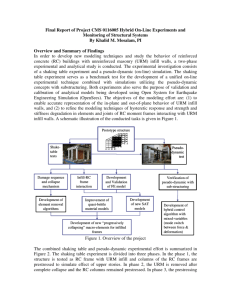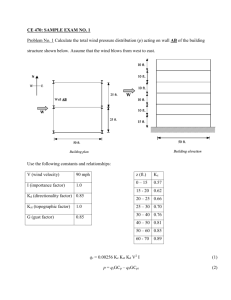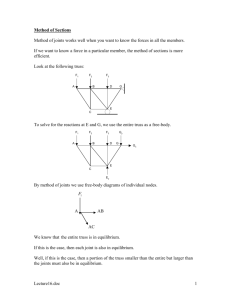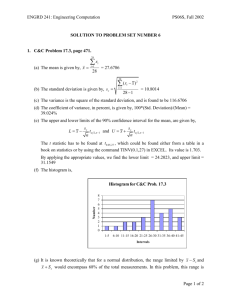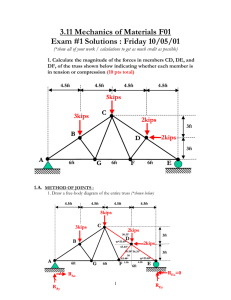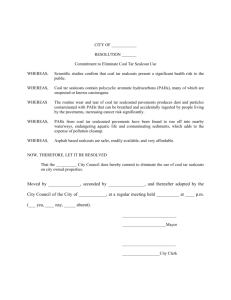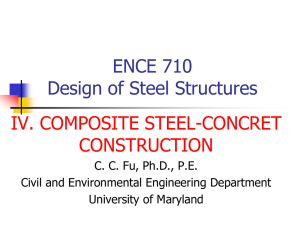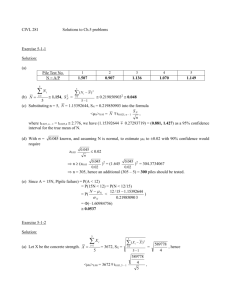Shake-Table Experiment on One- Story RC Structure With and
advertisement
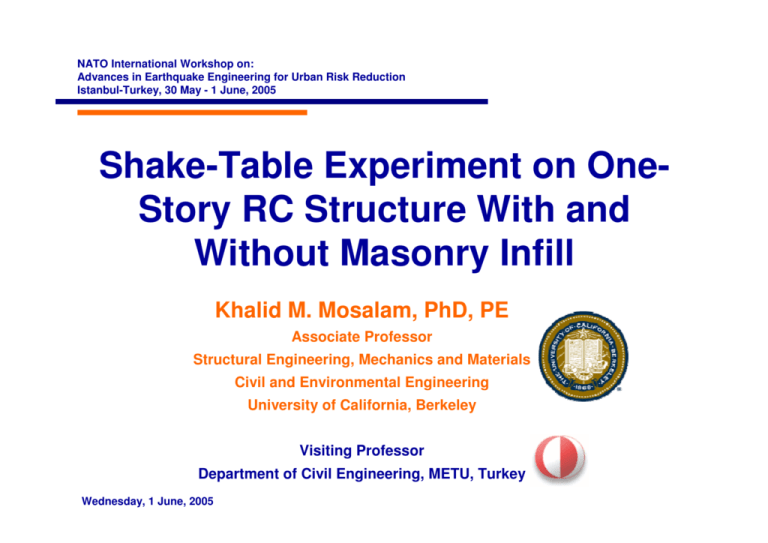
NATO International Workshop on: Advances in Earthquake Engineering for Urban Risk Reduction Istanbul-Turkey, 30 May - 1 June, 2005 Shake-Table Experiment on OneStory RC Structure With and Without Masonry Infill Khalid M. Mosalam, PhD, PE Associate Professor Structural Engineering, Mechanics and Materials Civil and Environmental Engineering University of California, Berkeley Visiting Professor Department of Civil Engineering, METU, Turkey Wednesday, 1 June, 2005 Outline • The Big Picture • Objectives • Test Structure • Test Stages • Earthquake Loading • Test Results • Concluding Remarks • Further Studies The Big Picture … Prototype structure Shaketable tests Pseudodynamic tests Damage sequence & collapse mechanism Infill-RC frame interaction Development of element removal algorithms Improvement of quasi-brittle material models Development and validation of FE model Development of new SAT models Development of new “progressively collapsing” macro-elements for infilled frames Validation of pseudo-dynamic with sub-structuring Development of hybrid control algorithm with mixed-variables (mode switch between force & deformation) Objectives • Develop a “benchmark” shake-table experiment for • validation of “new” experimental techniques and computational models Develop a new experimental technique: • Multiple physical sub-structures with different properties (bare versus URM • • infilled RC frames) tested simultaneously (at different locations) Mixed variable (force & displacement) pseudo-dynamic formulation based on relative stiffness of sub-structures or change of stiffness of one sub-structure Replacing physical modeling with a simulated model of one or more substructures, e.g. the connecting floor slab or upper stories • Develop computational models for URM infill walls • Model the collapse mechanisms of infilled frames Test Structure (1/4) C2 B C1 E C1 C B1 A A1 F A2 C D B2 C B1 E A1 F C2 D B2 B A2 Prototype “hypothetical” building Shake-table test structure Test Structure (2/4) • The prototype RC building is a 5-story structure designed following ACI318-02 & NEHRP recommendations in seismic regions. • URM wall (clay bricks & type N mortar) in one of the interior frames. • Test structure is a ¾-scale of the first story with column axial load (concentric post-tensioning) simulating upper floors gravity load. • Uniform mass is added to the slab such that the base-shear on the test structure matches that of the three middle frames of the prototype building model subjected to the design ground motion. Test Structure (3/4) • 18 accelerometers measured the base and roof accelerations at various locations and directions. • 95 displacement transducers measured global and local displacements and rotations. • 150 strain gages measured strains at different locations of the reinforcing bars and column post-tensioning rods. • 17 high speed cameras monitored the experiment. Test Structure (4/4) N Test Stages (1/2) Post-tensioning Stage 1 Stage Stages 2 and 3 Description 1 Infilled structure with column post-tensioning 2 Bare structure with column post-tensioning 3 Bare structure without column post-tensioning Test Stages (2/2) Test Movies Camera 14 Movie Description 1 Stage 1: Wall cracking 2 Stage 1: Wall crushing 3 Stage 1: Wall collapse 4 Stage 2: Post-tensioning acting as a self-centering system 5 Stage 3: On the verge of collapse (reaching the table limits) Earthquake Loading (1/2) Northridge, Tarzana 1.8 Spectral Acceleration [g] 1.6 Natural period range of the infilled structure Natural period range of the bare structure Design Spectra 1.4 1.2 Loma Prieta 1 Northridge 0.8 Duzce 1 0 -1 0 Acceleration [g] 2 5 1 0 -1 0 1 0 -1 0 0.6 0.4 0.2 0 0 0.5 1 Period [sec] 1.5 2 10 15 Duzce 20 25 5 10 15 20 Loma Prieta, Bran 25 5 25 10 15 time [sec] 20 Earthquake Loading (2/2) From PEER Strong Motion Database Ground Motion Station (Source) Direction PGA [g] PGV [in/sec (mm/sec)] PGD [in (mm)] Northridge, CA, ‘94 Tarzana 090 1.570 36.23 (920) 5.13 (130) Duzce, Turkey, ‘99 Lamont N 0.762 12.97 (329) 0.75 (19) Loma Prieta, CA, ‘89 Bran 000 0.426 17.43 (443) 2.28 (58) Scale Factors for Different Levels of Input Table Motion Level 1 probability of being exceeded in 50 years - 2 3 4 50% 30% 10% 6 7 8 9 - 2% Northridge, CA, ‘94 (TAR) 0.05 0.17 0.23 0.39 0.59 - - Duzce, Turkey, ‘99 (DUZ) - - - - - 1.50 2.00 2.53 Loma Prieta, CA, ‘89 (LomaPr) - 0.31 0.44 0.67 1.00 1.50 1.95 2.19 Design MCE Higher demands Test Results (1/7) Damaged infill wall 200 Maximum Base Shear (kips) 180 160 140 120 100 80 60 Test Results Elastic with wall Elastic without wall 40 20 Damaged RC frame 0 0 0.5 1 1.5 2 Maximum Drift(%) 2.5 3 Test Results (2/7) In-plane (North-South direction) Conditions of the test structure at time of the snap-back (pull) test Out-of-plane (East-West direction) Natural Period [sec] Damping Ratio [%] Stiffness [kips/in (kN/mm)] Natural Period [sec] Damping Stiffness Ratio [kips/in [%] (kN/mm)] Before building the wall No additional mass 0.135 4.30 113.3 (19.84) 0.134 4.40 134.0 (23.47) After building the wall Columns prestressed No additional mass 0.055 5.70 425.5 (74.52) 0.122 4.30 167.1 (29.26) After building the wall Columns prestressed With additional mass 0.134 6.85 431.0 (75.48) 0.232 4.25 168.0 (29.42) Test Results (3/7) 350 300 250 Test results 200 Initial stiffness with wall 150 Initial stifness without wall 180 160 100 Masonry Infill RC Frame 140 50 0 TAR 1 TAR 2 TAR 3 TAR 4 TAR 6 DUZ 7 DUZ 8 DUZ 7-2 Test Levels Variation of the effective stiffness From column shears using B.M. obtained from strain measurements and section properties Base Shear [kips] Effective Stiffness [kips/in] 400 120 100 80 60 40 20 0 TAR 3 TAR 4 TAR 6 DUZ 7 DUZ 8 DUZ 7-2 Test Levels Distribution of base shear between the URM infill wall and the RC frames 200 200 150 150 100 100 Base Shear [kips] Base Shear [kips] Test Results (4/7) K = 386 kips/in 50 0 -50 -50 -150 -150 -3 -2 -1 0 1 Displacement [in.] 2 3 Tarzana level 3 K = 284 kips/in 200 K = 190 kips/in 150 100 50 K = 57 kips/in 0 -50 -100 -3 -2 -1 0 1 Displacement [in.] 2 3 Tarzana level 6 200 150 K = 273 kips/in 100 50 K = 53 kips/in 0 -50 -100 -150 -150 K = 150 kips/in -200 -200 K = 168 kips/in -3 -200 Base Shear [kips] Base Shear [kips] 0 -100 Stage 1 of testing K = 270 kips/in 50 -100 -200 K = 359 kips/in -2 -1 0 1 Displacement [in.] Ducze level 7 2 3 -3 -2 -1 0 1 Displacement [in.] Ducze level 8 2 3 Test Results (5/7) 2.5 ← Begining of the test ← TAR 6 Spectral Acceleration [g] 2 ← Removal of the wall LomaPrieta Duzce Northridge Design Spectra ← Before removal of prestressing ← After removal of prestressing 1.5 ← End of 1 the test 0.5 0 0 0.2 0.4 0.6 Period [sec] 0.8 1 Change in spectral demand due to the change in natural period of the test structure Test Results (6/7) 2500 2000 Maximum Base Moment [kip-in] Stage 1 Stage 2 Stage 3 DUZ 8 1500 LomaPr 7 1000 LomaPr 9 DUZ 7 LomaPr 9-2 500 0 0 LomaPr 7-2 AWR-DUZ 7 0.01 0.02 0.03 0.04 0.05 C2 B C1 Maximum Top Moment [kip-in] 2500 2000 AWR-DUZ 8 Stage 1 Stage 2 Stage 3 LomaPr 9 1500 1000 500 LomaPr 9-6 LomaPr 8-2 DUZ 8 LomaPr 9-2-4 LomaPr 6-2 DUZ 7 LomaPr 4-2 0 0 0.01 0.02 0.03 0.04 0.05 Maximum Top Rotation [rad] Column A2, beam-column joint 0.06 C B1 E LomaPr 9 LomaPr 9-4 LomaPr 7-2 DUZ 7 500 0.01 0.02 0.03 0.04 0.05 0.06 Maximum Base Rotation [rad] F A2 C D B2 LomaPr 7 1000 0 0 Column A2, column-foundation joint DUZ 8 1500 0.06 Maximum Base Rotation [rad] Stage 1 Stage 2 Stage 3 2000 Column B1, column-foundation joint A1 2500 Maximum Top Moment [kip-in] Maximum Base Moment [kip-in] 2500 LomaPr 9 LomaPr 9-6 LomaPr 9-2-4 2000 LomaPr 7 Stage 1 Stage 2 Stage 3 LomaPr 4-2 1500 DUZ 8 1000 AWR-TAR 4 500 DUZ 7 0 0 TAR 4 0.01 0.02 0.03 0.04 0.05 Maximum Top Rotation [rad] Column B1, beam-column joint 0.06 Test Results (7/7) 200 180 DUZ 7 DUZ 8 Stage 1 Stage 2 Stage 3 LomaPr 9 Maximum Base Shear [kips] 160 LomaPr 7 140 TAR 6 LomaPr 9-6 DUZ 7-2 120 AWR-DUZ 8 LomaPr 7-2 100 LomaPr 9-2-1 TAR 4 AWR-DUZ 7 80 LomaPr 6-2 60 LomaPr 9-2-4 TAR 3 LomaPr 4-2 40 LomaPr 3-2 LomaPr 2-2 20 0 0 LomaPr 8-2 1 2 3 4 5 Maximum Drift [%] Global Results 6 7 8 Concluding Remarks (1/2) • Test structure at design level showed 17% reduction of stiffness, but the overall behavior is almost linear. • At MCE, first significant damage occurred with 25% shift of stiffness from beginning to end of motion with cracking along column-wall interface and small vertical cracks in mortar joints at the corners. • Most significant change in behavior occurred at DUZ 7 (1.5 original) with significant wall cracks (large cracks at 60o with hrz. connected with a hrz. crack & 45o crack into opposite bottom corners.) • For small drifts (< 0.2%), cracks opened and closed without engaging the wall. Once the cracks closed, the wall picked up load causing stiffness increase and further wall damage. Concluding Remarks (2/2) • At small forces, static friction between cracked surfaces existed and the wall acted as a whole increasing the stiffness. Afterwards, the stiffness reduced approaching to that of the bare RC frames. • Damage in the URM infill increased the natural period from 0.13 sec to 0.36 sec (167% increase). • Removal of post-tension rods increased the natural period from 0.44 sec to 0.61 sec (39% increase). • URM infill wall significantly changed the demands and the key global and local response parameters, e.g. drift ratio, base shear and joint rotations. • The experimental findings represent benchmark dynamic test data to validate newly developed on-line testing with hybrid control and sub-structuring. Further Studies Pseudo-Dynamic Experimentation Computational substructure 3-frame 5-story building Physical substructures Bare frame Infilled frame Setup in nees@berkeley facility for pseudo-dynamic testing Comparisons Shake-table test Shake-table results Pseudo-dynamic test Pseudo-dynamic results 200 200 100 TAR 6 140 DUZ 8 DUZ 7-2 120 100 60 40 0 0 0 -50 -100 -150 -150 -2 -1 0 1 2 -200 -3 3 160 Shake-table test TAR 2 TAR 1 0.5 Masonry Infill 1 1.5 2 Maximum Drift [%] 2.5 3 1 2 3 Masonry Infill RC Frame 160 140 120 100 80 60 120 100 80 60 40 40 20 20 0 0 RC Frame 140 TAR 3 -1 180 180 TAR 4 -2 Displacement [inch] Displacement [inch] Pseudo-dynamic test 20 -50 50 -100 Base Shear [kips] 80 0 -200 -3 Duzce Level 7 Duzce Level 8 100 50 Base Shear [kips] Maximum Base Shear [kips] 160 DUZ 8 150 Duzce Level 8 Base Shear [kips] 180 Duzce Level 7 150 DUZ 9 Base Shear [kips] DUZ 7 200 TAR 3 TAR 4 TAR 6 DUZ 7 DUZ 8 DUZ 7-2 Test Levels 0 TAR 3 TAR 4 TAR 6 DUZ 7 DUZ 8 DUZ 9-2 Test Levels Errors (1/3) Fw: Infill resisting force FI: Inertia force FD: Damping force FF: Concrete frame resisting force FI + FF + FW + FD = ε Model for ε as error in a similar run after removal of the wall FW = 0 ⇒ ε1 = FI + FF = − FD + ε = −C.uɺ + ε ⇒ ε Inputs (U): FF , ground displacement ε : error term na nb nc i =1 j =1 k =1 ε (t ) = −∑ ai .ε (t − i ) + ∑ b j .U (t − j − 1) + ∑ ck .ε o (t − k ) FˆW = − FI − FD − FF − ε = − m.uɺɺt − C .uɺ − FF − ε Estimate of FW considering the error terms with model without model 150 100 100 50 FW [kip] with model without model 0 -50 -100 -150 14.7 14.8 14.9 15 15.1 15.2 15.3 15.4 Time [sec] 0 with model without model 100 -50 50 FW [kip] FW [kip] Better estimation of infill resisting force (FW) using ARMA model 50 -100 0 -50 -100 -150 5 10 15 Time [sec] 20 25 30 8 8.2 8.4 Time [sec] 8.6 8.8 Displacement [inch] Errors (2/3) 5 comand feedback 0 -5 0 500 1000 1500 2000 2500 3000 3500 500 1000 1500 2000 2500 3000 3500 Displacement [inch] (zoomed in) Error [inch] 0.04 0.02 0 -0.02 -0.04 0 -0.5 comand feedback -0.6 -0.7 -0.8 -0.9 1209.5 1210 1210.5 1211 1211.5 1212 1212.5 1213 1213.5 Time Step Error in implementing target displacement command is unavoidable in PID control Errors (3/3) FFT 0.3 Disp 100*Error 0.2 Er(t) = 0.03e 0.1 0 0 1 2 3 4 5 6 7 8 9 (0.78 v -1) 10 1000 0.035 500 0.03 0 0 1 2 3 4 5 6 7 8 9 10 1000 FFT f*Disp/Error 500 0 0 1 2 3 4 5 Frequency, Hz 6 7 8 9 10 Absolute Value of Error [inch] FFT Disp/Error 0.025 0.02 0.015 Recorded Modeled 0.01 0.005 0 0 0.2 0.4 0.6 0.8 1 Absolute Value of Velocity [inch/sec] 1.2 1.4 Developing Computational Models (1/2) • Assessment of existing algorithms for manual and semi-automatic element removal and potential for use in progressive collapse analysis • Case study: Masonry-infilled onestory structure: – Masonry modeled by three diagonal struts in compression – Dynamic analysis: center strut brittle failure during Northridge Tarzana record Case study specimen and OpenSees model rendition Developing Computational Models (2/2) Displacement envelope doubled Center Strut Removed 0.2 0.1 0 -0.1 No Element Removal (Ductile Center Strut) Brittle Center Strut -0.2 0 2 4 6 8 10 12 14 16 18 20 → • Residual displ. reversed • Demand on other elements rose more likely to fail • Needs reliable automation – Internal force release – Element loads – ”Dangling” nodes Time (sec.) Force in Opposite Center Strut (kip) • Roof Displacement (in.) 0.3 0 -10 -20 Ductile Center Strut Brittle Center Strut -30 Original Strut force history shown in dotted light black for reference (for the ductile softening case). -50 Strut force capacity is 50 kips and should be removed afterwards -60 -40 0 2 4 6 Strut Force Capacity Opposite Center Strut should fail. Procedure is doable but tiresome and not guaranteed 8 10 12 14 16 18 20 Time (sec.) Roof displacement and strut force time history for ductile and brittle failure of one center strut Developing Computational Models Steel Shoe Steel Shoe t1 pi = t2 z x y ti t1 + t 2 ∑p 1 ∑ ∫Vi (σ x )i dV V 1 ε x = ∑ ∫ (ε x )i dV Vi V i = 1 for brick & 2 for mortar σx = i =1 Development of new SAT Models for infilled frames • In-plane SAT models 12 9 8 • Combination of In-plane and Out-of-plane SAT models 3 7 5 13 11 20 22 14 1013 21 19 8 14 12 2 7 1 1 1.2 5 Link element 6 • Material properties for various elements of the SAT model 1 5 4 Axial Force(kips) Stress(ksi) 0.8 0.6 3 2 0.4 1 0.2 0 -1 -15 0 0 0.2 0.4 0.6 0.8 Strain 1 1.2 1.4 1.6 -10 80 70 60 15 40 Horizontal Force(kips) 60 Horizontal Force(kips) 10 PushOver Analysis 80 50 40 PN/P D = 0 30 PN/P D = 0.01 PN/P D = 0.05 20 20 0 -20 -40 PN/P D = 0.10 PN/P D = 0.15 -60 PN/P D = 0.20 10 PN/P D = ∞ 0 0 5 Axial Displacement(in) -3 x 10 PushOver Analysis • Considering the effects of outof-plane and cyclic loading in in-plane degradation of the infill. -5 0 0.2 0.4 0.6 0.8 1 Horizontal Displacement(in.) 1.2 1.4 -80 -1 1.6 -0.8 -0.6 -0.4 -0.2 0 0.2 0.4 Horizontal Displacement(in.) 4 2 6 18 16 Compression struts 6 10 17 15 11 3 9 4 0.6 0.8 1

